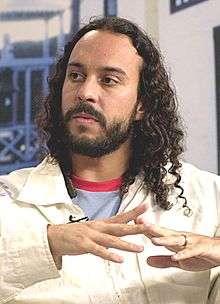Gabriel o Pensador
| Gabriel o Pensador | |
|---|---|
 Gabriel o Pensador on an interview | |
| Background information | |
| Birth name | Gabriel Contino |
| Born |
March 4, 1974 Rio de Janeiro, RJ, Brazil |
| Genres | Hip hop |
| Occupation(s) | Rapper, writer, composer |
| Years active | 1992–present |
| Labels | Sony-BMG |
| Associated acts | Detonautas Roque Clube,[1] Boss AC,[2] Fabio Fonseca[a], [b], Itaal Shur[c], Lulu Santos |
| Website |
www |
Gabriel Contino, better known as Gabriel o Pensador (Portuguese for "Gabriel the Thinker") is a Brazilian rapper, writer, and composer known for his intellectual lyrics which talk of activism, and issues of race, politics, social problems, and the Catholic church.[3] Gabriel began his music career when he launched a demo tape containing the song "Tô Feliz (Matei o Presidente)" I'm Happy (I killed the President) landing him a contract with Sony Music. Since then he has released eight albums: Ainda É Só o Começo, Quebra-Cabeça, Nádegas a Declarar, Gabriel o Pensador, Seja Você Mesmo (mas não Seja sempre o Mesmo), MTV ao Vivo, Cavaleiro Andante and Sem Crise (this last one was released independently). Gabriel has also written three books: "Diário Noturno", "Um Garoto Chamado Rorbeto" and "Meu Pequeno Rubro-Negro". "Um Garoto Chamado Rorbeto" won the "Prêmio Jabuti", for best Children's literature.[4]
Biography
Coming from a middle-class family,[5] a unique background among Brazilian rappers, Gabriel, the son of a well known journalist in Brazil, hit fame in 1992 with the song "Tô Feliz (Matei o Presidente)" ("I' m happy, I've killed the president"), the debut single from his first and eponymous album. This song was written in protest of President Fernando Collor de Mello and his corrupt administration. Interestingly, Gabriel's mother was Collor's press secretary.[6] The same album also yielded other hits, including "Lôrabúrra" ("Dumb Blonde", shortened) and "Retrato de um Playboy" ("Portrait of a Playboy"), bringing hip hop mainstream attention in Brazil by catering to the middle class. Although rapping about everyday life, Gabriel also found time to talk about social injustices with his fourth single, "O Resto do Mundo" ("The Leftovers of the World", a pun on the words "leftovers" and "rest" being the same word), a more downbeat track about homeless life, with a purposefully depressive melody and flow. Gabriel was "notorious for his biting attacks on some of the major ills of Brazilian society: poverty, racism, violence."[7]
His following albums were also commercially successful, with a careful blend of socially relevant tracks mixed with airwave-minded pop anthems. His third album, Quebra-Cabeça, was released in 1997 and sold over one million copies.[6] History-minded, Gabriel was highly influenced by other Brazilian music, including bossa nova, samba and MPB, as well as using hip hop's traditional methods of sampling jazz, funk and disco ("2345meia78", for example, sampled Chic's "Good Times").
In 1994, while touring in Portugal, Gabriel's song "Lavagem cerebral" (Brainwashing) was received with much praise. The piece was accepted as "a strong social critique of Brazilian society and of the ideology of the dominating classes."[7]
Besides his native Brazil, Gabriel, o Pensador is also well known in Portugal, Angola, Cape Verde, Mozambique, and has worked with Portuguese musicians like Sérgio Godinho and General D.
Other projects
The musician has also released three books: "Diário Noturno" (Brazil and Portugal; poems and short stories), "Um garoto chamado Rorbeto" (Brazil; fiction poetry for children) "Meu Pequeno Rubro-Negro" (Brazil; about children who support Flamengo, like himself). He has been a juror on the spelling bee contest "Soletrando" (in its second edition) on the program Caldeirão do Huck.[8] Concerned about the truancy among a group of boys he helped in Rocinha, in , Rio de Janeiro, Gabriel put his hands to work and created an NGO called "Pensando Junto"(Portuguese for Thinking Together), an organization serving a social, educational and cultural purpose for children and youth in the community of Rocinha, providing its participants with access to culture, education, leisure, food, medical, dental and psychological care. The organization offers tutoring and courses for a group of underprivileged children in the Rocinha district, located in Gabriel's hometown of Rio de Janeiro, where he still lives in today.[9][10] Gabriel is also a member of the Dreams Can Be Foundation, a nonprofit charitable supporting organization and a Brazilian NGO dedicated to aiding street children and impoverished youth in Brazil, working in partnership with local organizations and NGOs to provide: education, moral and social development, humanitarian relief, and the offering of opportunities where there were none before.[11]
Discography
- 1993 Gabriel Pensador
- 1995 Ainda é só o Começo
- 1997 Quebra-Cabeça
- 1999 Nádegas a Declarar
- 2001 Seja Você Mesmo, Mas Não Seja Sempre o Mesmo
- 2002 MTV Ao Vivo
- 2005 Cavaleiro Andante
- 2012 Sem Crise
References
- ↑ "Detonautas – biografia". Studio Matheus Levi. Retrieved October 10, 2013.
- ↑ Estrela, Filipa. "AC Para os Amigos é o novo disco do Boss". Destak. Retrieved October 10, 2013.
- ↑ Magaldi, Cristina (October 1999). "Adopting imports: New images and alliances in Brazilian popular music of the 1990s". Popular Music. 18 (3): 21. doi:10.1017/s0261143000008898.
- ↑ "Gabriel O Pensador leva prêmio Jabuti de melhor livro infantil". Folha Online: Ilustrada.
- ↑ Bollig, Ben (Fall–Winter 2002). "White Rapper/Black Beats: Discovering a Race Problem in the Music of Gabriel o Pensador". Latin American Music Review. 23 (2): 19. doi:10.1353/lat.2002.0017.
- 1 2 Gabriel o Pensador
- 1 2 Behague, Gerard. "Rap, Reggae, Rock, or Samba: The Local and the Global in Brazilian Popular Music (1985–95)." Latin American Music Review 27, no.1 (Spring/Summer 2006): 79–90.
- ↑ http://www.portal151.com.br/salaimprensa.php?2011/10/23/gabriel-o-pensador-a-estrela-da-campanha-pela-regulamenta-o-da-conven-o-151.html
- ↑ Redação Tititi. "Gabriel O Pensador tem ONG que oferece reforço escolar". Educar Para Crescer.
- ↑ "Ong Pensando Junto (Gabriel O Pensador)". Rocinha.ORG.
- ↑ "About Us". Dreams Can Be Foundation.